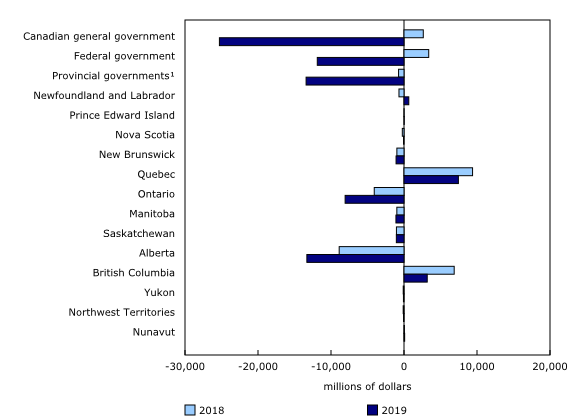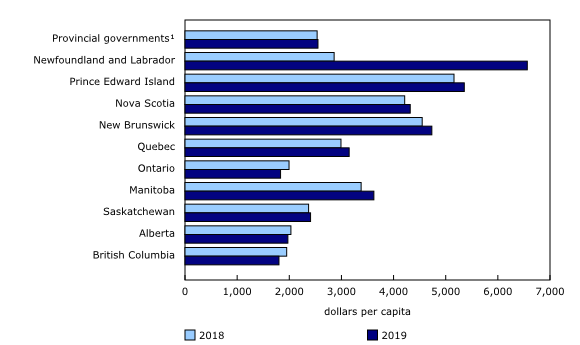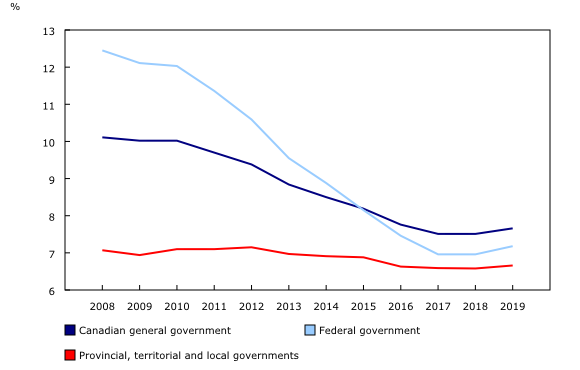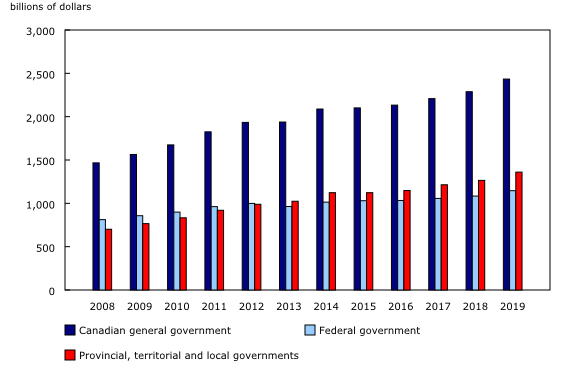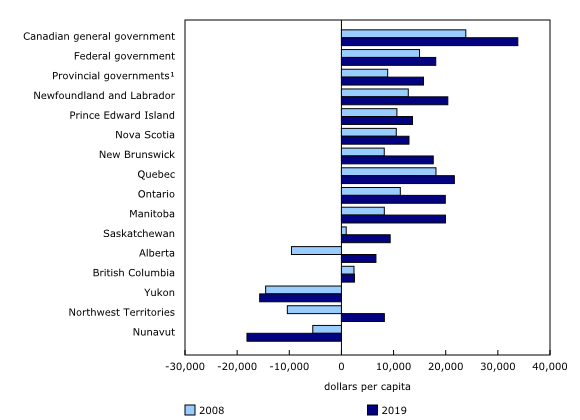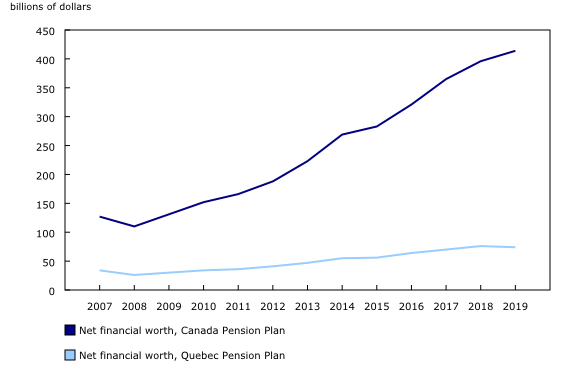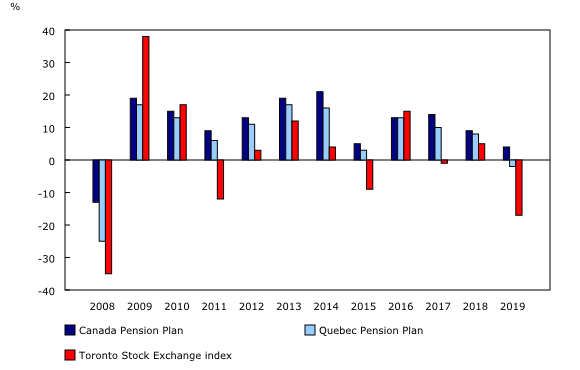Largest deficit in seven years in 2019; full impact of pandemic yet to be seen
Archived Content
Information identified as archived is provided for reference, research or recordkeeping purposes. It is not subject to the Government of Canada Web Standards and has not been altered or updated since it was archived. Please "contact us" to request a format other than those available.
Released: 2020-11-18
The consolidated Canadian general government (CGG)—federal, provincial, territorial and local governments combined—recorded a deficit of $25.3 billion in 2019, compared with a surplus of $2.6 billion in 2018. That deficit equalled 1.1% of gross domestic product (GDP) in 2019, the largest in seven years (2.1% in 2012).
The deficit is largely explained by the weakest tax revenue growth (+2.0%) since the recovery from the 2008 financial crisis, combined with 5.1% growth in expenses, an above-average pace for the same period (+3.6%).
The federal government and the consolidated provincial, territorial and local governments (PTLGs) contributed almost equally to the CGG deficit in 2019. The federal government posted a deficit of $11.9 billion, compared with a $3.4 billion surplus the previous year. As for PTLGs, the deficit widened rapidly to reach $13.4 billion, compared with $0.7 billion in 2018.
COVID-19 impacts on the 2019 reference year
The 2019 reference year corresponds to the fiscal year ending March 31, 2020, for the federal, provincial and territorial governments. The current estimates include, among other things, retroactive payments for the Canada Emergency Wage Subsidy (CEWS).
The marked decline in economic activity in the 2020 reference year, coupled with broad fiscal measures implemented in response to the COVID-19 pandemic, will lead to record deficits, especially for the federal government.
The net operating balance, also referred to as surplus or deficit, is calculated as revenues minus expenses over a given reference period and constitutes a summary measure of the sustainability of government operations.
In 2019, PTLG expenses (+3.6%) grew faster than revenues (+1.5%), reaching $616.4 billion. The increase in expenses was primarily driven by higher compensation of employees (+$6.7 billion), use of goods and services (+$4.9 billion), and subsidies to enterprises (+$2.5 billion).
For the federal government, expenses (+6.8%) also grew much faster than revenues (+2.2%) and stood at $359.9 billion. This increase was notably driven by higher subsidies (+$4.7 billion) such as CEWS and various new agriculture and housing programs, other transfers to individuals (+$4.5 billion) related to federal fuel charge proceeds returned and the Indian Day School Settlement, compensation of employees (+$2.9 billion), and Old Age Security (OAS) benefits (+$2.8 billion).
At the PTLG level, Nunavut (2.4%), Newfoundland and Labrador (1.9%), and Quebec (1.6%) recorded significant surpluses as a percentage of GDP in 2019. The surplus in Newfoundland and Labrador is attributable to higher federal transfers related to the 2019 Atlantic Accord.
The largest deficits as a percentage of GDP were in Alberta (3.8%), New Brunswick (2.8%) and Yukon (2.4%). New Brunswick has recorded steady, large deficits over the past 12 years.
Fiscal burden decreases as gross domestic product grows faster than government revenues
Consolidated revenues for CGG were $848.8 billion in 2019, up 1.7% from 2018. The growth in revenues was the lowest recorded since the recovery from the 2008 financial crisis, while nominal GDP grew 3.6% during the year. Taxes and social contributions accounted for 82.8% ($703.0 billion) of total revenues, or 30.4% of GDP, down 0.5 percentage points compared with 2018. This amounted to $18,509 per capita in 2019.
Fiscal burden measures the taxes and social contributions (compulsory transfers) paid to governments by individuals, businesses and non-residents, expressed as a percentage of GDP. Personal income taxes and general sales taxes (such as the goods and services tax and the harmonized sales tax) paid by households accounted for 55.8% of all taxes and social contributions paid in Canada in 2019.
The decrease in the fiscal burden in 2019 is mainly attributable to a 0.4 percentage point decline for PTLGs (16.3%). Among the provinces, the largest movements in 2019 were in Newfoundland and Labrador (-1.1 percentage points), Alberta (-0.9), Prince Edward Island (-0.6) and British Columbia (-0.6). Quebec continued to have the highest fiscal burden, at 21.5%, while the lowest remained in Alberta (10.2%).
The territories recorded a significantly lower fiscal burden than the provincial average, with Nunavut posting the lowest in 2019, at 4.4%. The territories rely heavily on federal transfers to deliver essential goods and services to the population. In 2019, taxes and social contributions accounted for 12.3% of total revenues in the territories, compared with 74.9% for transfers from the federal government. These transfers amounted to $51,763 per capita in Nunavut, $36,282 in the Northwest Territories and $28,895 in Yukon.
Newfoundland and Labrador receives the highest grant revenue per capita among the provinces
The federal government extends different types of grants to provinces and territories to help them provide essential programs and services to all Canadians, such as health care, education, social assistance and childhood development. The largest transfers are the Canada Health Transfer, the Canada Social Transfer, equalization payments and territorial formula financing.
In 2019, the provinces and territories received $96.8 billion in grants, a 2.1% increase from 2018. Receipts for both Quebec and Ontario (61.3% of the Canadian population) accounted for 55.7% of PTLG grant revenue. On a per capita basis, federal grants received by PTLGs stood at $2,550 in 2019, compared with $2,534 in 2018.
Among the provinces, Newfoundland and Labrador received the highest grants per capita ($6,564) in 2019, followed by Prince Edward Island ($5,356) and New Brunswick ($4,734). The large increase in grants per capita (+129.5%) in Newfoundland and Labrador was the result of the $1.9 billion federal transfer recorded for the 2019 Atlantic Accord. In contrast, grants per capita to British Columbia were the lowest ($1,802) in Canada, closely followed by Ontario ($1,833) and Alberta ($1,973).
Double-digit growth in federal transfers is expected in 2020 to support provincial and territorial governments' responses to the COVID-19 pandemic.
Interest expenses remain low despite steady increase in debt
In 2019, the CGG paid 7.7 cents in interest charges for every dollar of revenue received, up from 7.5 cents in 2018. Interest expenses accrued on debt liabilities totalled $65.0 billion (or $1,712 per capita). Despite an increase of 88.3% in total liabilities ($2,434 billion in 2019) since before the 2008 financial crisis, the ratio was significantly down from 10.1 cents in 2008 because of historically low interest rates on the outstanding debt.
The ratio of interest charges to revenue is expected to increase significantly in 2020 given the scale of new government debt securities issuance combined with declining revenues related to the COVID-19 pandemic.
The federal government paid 7.2 cents in interest for every dollar of revenue received in 2019, compared with 6.7 cents for PTLGs. Quebec (9.6 cents) and Manitoba (9.6 cents) spent the most on interest per dollar of revenue in 2019, followed by New Brunswick (6.7 cents) and Ontario (6.7 cents).
Gross debt above 105% of gross domestic product, and much more is yet to come
The CGG's net liability ($1,285 billion) increased by 8.4%, or $99.3 billion, from 2018. Net liability corresponds to total liabilities minus total financial assets and is referred to as net debt in public accounts. Financial assets grew 4.2% to $1,149 billion ($30,263 per capita), while liabilities increased 6.4% to $2,434 billion ($64,087 per capita). The CGG's ratio of total liability (or gross debt) to GDP stood at 105.3% in 2019 (up 2.8 percentage points from 2018).
Debt figures are expected to rise significantly in 2020 resulting from massive new borrowing to cover expected historic deficits from relief measures implemented in response to the COVID-19 pandemic.
Net liability for the federal government ($686.9 billion) rose by $40.5 billion in 2019, compared with a $58.8 billion increase for PTLGs ($597.7 billion). Yukon (-15.6%) and Newfoundland and Labrador (-5.1%) were the only jurisdictions to record a reduction of net liability compared with 2018. Among the provinces, the largest increases were recorded in Alberta (+81.6%), New Brunswick (+18.5%) and British Columbia (+15.7%). In absolute terms, net liability grew $51.9 billion in Ontario (+$23.5 billion), Quebec (+$15.3 billion) and Alberta (+$13.1 billion) alone. The three provinces contributed to 88.2% of the total PTLG increase in net liability.
Quebec recorded the highest PTLG net liability per capita ($21,657, or 40.3% of GDP), followed by Newfoundland and Labrador ($20,404, or 30.2% of GDP), Manitoba ($19,948, or 37.3% of GDP), and Ontario ($19,914, or 32.9% of GDP). Among other provinces, British Columbia posted the lowest net liability per capita ($2,497, or 4.2% of GDP) in 2019, followed by Alberta ($6,617, or 8.3% of GDP), both well below the Canada-level total for PTLGs ($15,738, or 25.9% of GDP).
Yukon and Nunavut were the only jurisdictions to post a positive net financial worth (financial assets minus liabilities) in 2019. Debt in the territories is low compared with the provinces since their borrowing capacity is restricted to limits set by the federal government.
The ratio of federal government net liability to GDP remained below the 30% level in 2019, at 29.7% (up 0.7 percentage points). This ratio is a key measure of the sustainability of fiscal policy. On a per capita basis, net liability increased 4.7% to $18,087. Debt securities ($861.5 billion) and federal employees' pension plan liabilities ($166.9 billion) represented 89.7% of total liabilities ($1,145.9 billion) in 2019.
Canada Pension Plan and Quebec Pension Plan investments grow at a slower pace
The Canada Pension Plan (CPP) and Quebec Pension Plan (QPP) are the largest social security funds in the country. Along with OAS, they are the foundation of Canada's public retirement income system.
In 2019, Canadian workers and employers paid $71.7 billion (+7.2%) in contributions to the CPP and QPP. In turn, beneficiaries received $64.1 billion (+4.8%) in pensions and benefits. For the year, the funds' net financial worth climbed 3.3% (+4.4% for the CPP and -2.3% for the QPP) to $487.9 billion, significantly lower growth compared with the average of the last 10 years (+13.4%).
The returns of social security funds were impacted by the sharp decline in stock market values in March 2020 following the spread of COVID-19 in Canada.
The CPP's and QPP's net financial worth measures the current assets (net financial assets) available for the payment of future social security benefits. At the end of the reference period, net financial worth was $12,847 per capita, up 1.8% from $12,619 in 2018. Since 2008, the CPP's net financial worth has posted growth of 276%, while the QPP has recorded a 186% gain. For comparison, the Toronto Stock Exchange index grew 53% over the same period.
Note to readers
This release includes revisions to both unconsolidated and consolidated Canadian Government Finance Statistics (CGFS) data for the 2017 and 2018 reference periods, as well as the addition of the 2019 reference period.
Annual data correspond to the end of the fiscal year closest to December 31. For example, data for the federal government fiscal year ending on March 31, 2020 (fiscal year 2019/2020), are reported for the 2019 reference year.
Preliminary CGFS data are published eight months after the end of the fiscal year; therefore, estimates were prepared before several public accounts and financial statements were audited and published by government entities.
CGFS data differ from reports published by governments because of differences in institutional coverage, accounting rules, timing and integration with the Canadian macroeconomic accounts.
Consolidation is a method of presenting one overarching statistic for a set of units. It involves eliminating all transactions and debtor–creditor relationships among the units being consolidated. In other words, the transaction of one unit is paired with the same transaction as recorded for the second unit and both transactions are eliminated.
In 2019, the consolidation method removed $319.7 billion in internal revenues and expenses, as well as $249.0 billion related to internal debtor–creditor relationships for the Canadian general government (CGG).
Consolidated data are released for the CGG, which combines federal government data with provincial, territorial and local government (PTLG) data but excludes data for the Canada Pension Plan and Quebec Pension Plan.
Consolidated data are also released for PTLGs, which include provincial and territorial governments, health and social service institutions, universities and colleges, municipalities and other local public administrations, and school boards.
The constitutional framework of PTLGs in the territories differs from that in the provinces, leading to differences in the roles and financial authorities of government. These differences, as well as other geographic, demographic and socioeconomic dissimilarities between the North and the rest of Canada, give rise to marked disparities in government finance statistics.
PTLG data can be compared across provinces and territories because consolidation takes into account differences in administrative structure and government service delivery by removing the effects of internal public sector transactions within each jurisdiction.
Because PTLG finance statistics vary significantly across jurisdictions in Canada as a result of size differences, per capita data are used to facilitate comparisons. Per capita data are based on population estimates as of April 1 for Canada, the provinces and the territories, available in Table 17-10-0009-01.
Calculations as a percentage of gross domestic product (GDP) are based on estimates of GDP at current market prices, expenditure-based, for Canada, the provinces and the territories, available in Table 36-10-0222-01.
In this release, revenues, expenses, assets and liabilities are reported in nominal terms.
Net financial worth is defined as the total value of financial assets minus the total value of liabilities. When financial assets are greater than liabilities, the measure is referred to as net financial assets. When liabilities are greater than financial assets, the measure is referred to as net liabilities or net debt, as per public accounts.
Products
The Canadian Government Finance Statistics 2014 classification structure is now available in the Definitions, data sources and methods module of our website.
Additional information can be found in the Latest Developments in the Canadian Economic Accounts (13-605-X). The User Guide: Canadian System of Macroeconomic Accounts (13-606-G) is also available. This publication has been updated with Chapter 9. Government sector accounts in the Canadian System of Macroeconomic Accounts.
Contact information
For more information, or to enquire about the concepts, methods or data quality of this release, contact us (toll-free 1-800-263-1136; 514-283-8300; STATCAN.infostats-infostats.STATCAN@canada.ca) or Media Relations (613-951-4636; STATCAN.mediahotline-ligneinfomedias.STATCAN@canada.ca).
- Date modified:


